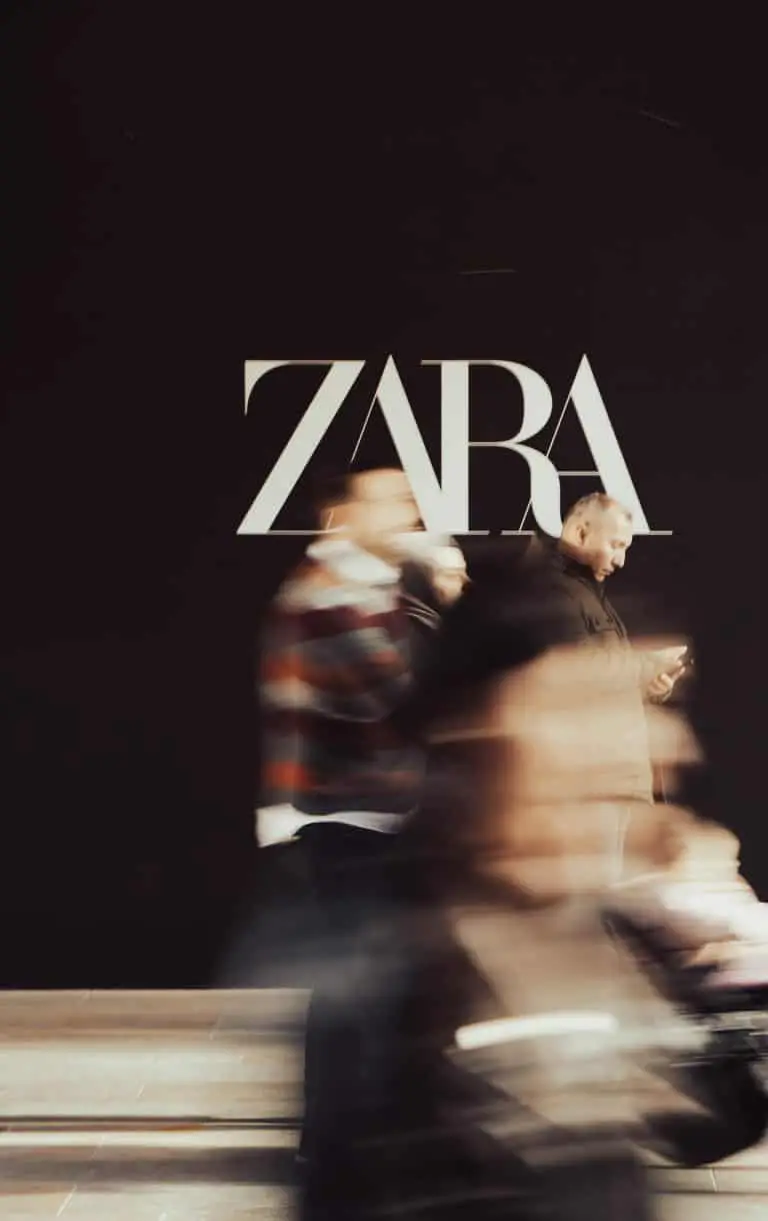When it comes to “Chanel vs. Zara: Contrasting Approaches to Luxury and Fashion,” one might wonder how these two seemingly disparate brands could even be compared.
Beneath the surface of luxury brands and fast fashion lies a compelling narrative of two divergent strategies within the industry, each influencing consumer tastes and driving success for both companies. A tale of two distinct approaches within the fashion industry that have shaped consumer preferences and defined success for both companies.
In this blog post, we will explore “Chanel vs. Zara: Contrasting Approaches to Luxury and Fashion” by examining their origins, philosophies, business models, advertising strategies, sustainability efforts, and unique customer bases.
As you journey through the contrasting worlds of Chanel’s timeless elegance and Zara’s ever-changing trends,
You’ll gain a newfound appreciation for what sets them apart in today’s competitive landscape – from Coco Chanel’s impact on women’s fashion to Zara’s founding principles rooted in affordability and accessibility.
We invite you to join us as we unravel the secrets behind these iconic brands’ successes while pondering over their future prospects in an increasingly eco-conscious society where sustainable practices are becoming paramount importance.
This exploration promises not only a fascinating insight into two major players in the world of fashion but also valuable lessons applicable across various industries about understanding your target audience and crafting a brand identity that resonates with them deeply.
Table of Contents:
- The Origins and Philosophies of Chanel and Zara
- Comparison of Business Models and Market Value
- Advertising Strategies for Building Brand Identity
- Sustainability Efforts Within the Fashion Industry
- Advertising Strategies for Building Brand Identity
- Sustainability Efforts Within the Fashion Industry
- Catering to Unique Customer Bases: Chanel vs. Zara
- Chanel vs. Zara: Contrasting Approaches to Luxury and Fashion
- Conclusion
The Origins and Philosophies of Chanel and Zara
Let’s delve into the intriguing past of two iconic fashion labels, Chanel and Zara. Are you ready? Let’s dive in.
Coco Chanel’s Impact on Women’s Fashion
In 1910, Gabrielle “Coco” Chanel revolutionized women’s fashion with her simple yet elegant designs. She did away with corsets and heavy fabrics, introducing comfortable clothing that allowed women to move freely while looking fabulous. “Fashion should be a form of escapism, not imprisonment,” she once said. And so began the era of modern luxury brands.
The Founding Principles of Zara
Moving forward to 1974, Amancio Ortega Gaona founded Zara in Spain as part of his Inditex group. Zara quickly became synonymous with fast fashion – trendy items at affordable prices produced rapidly to keep up with ever-changing consumer demands. This approach was vastly different from traditional luxury brands like Chanel but equally successful within its market segment.
Luxury Brands vs. Fast Fashion Philosophies:
- Luxury Brands: Emphasize exclusivity, craftsmanship, high-quality materials, and timeless appeal (think: investment pieces).
- Fast Fashion: Focuses on affordability, rapid trend turnover (hello FOMO.), disposable clothing, and mass production.
While Chanel epitomizes the luxury fashion experience with its iconic designs and exclusive clientele, Zara has found success by catering to budget-conscious consumers who crave trendy items without breaking the bank. Their contrasting philosophies have led both companies to become powerhouses within their respective markets – but can they coexist?
Let’s continue our journey into the world of fashion as we examine their business models, advertising strategies, sustainability efforts, and unique customer bases.
Comparison of Business Models and Market Value
Let’s dive into the contrasting business models of Chanel and Zara, two fashion powerhouses, and explore how these strategies have led to their respective successes in the luxury and fast-fashion markets. According to Forbes’ Global 2000 list, published in May 2023, LVMH Moet Hennessy Louis Vuitton SE ranks at #54 with a $52 billion market value, while Industria de Diseno Textil SA sits at #342 boasting a $25 billion market value.
Luxury vs. Fast-Fashion Strategies
Chanel focuses on exclusivity, craftsmanship, and high-quality materials to create timeless pieces that appeal to wealthy clientele seeking luxury items. In contrast, Zara is all about rapid trend turnover and affordable prices for budget-conscious consumers who want fashionable clothing without breaking the bank.
Revenue Comparison Between The Two Brands
In terms of revenue generation, Chanel reported a‚¬44.7 billion ($53.5 billion) in revenues for 2023. Inditex (parent company of Zara), however, recorded a‚¬20.4 billion ($24.4 billion) during the same period – almost half.
Advertising Strategies for Building Brand Identity
Both Chanel and Zara have distinct approaches to advertising, which contribute significantly to their brand identities.
Celebrity Endorsements by Chanel
Celebrity endorsements by Chanel, featuring A-list stars such as Nicole Kidman, Keira Knightley and Kristen Stewart in traditional marketing campaigns, help maintain the exclusive image associated with the brand. This strategy helps maintain the image of luxury and exclusivity associated with the brand.
Word-of-Mouth Promotion Strategy by Zara
Zara takes a different route – relying on word-of-mouth promotion through satisfied customers who spread the love for their trendy yet affordable clothing options. Whereas Chanel has an impressive 45 million Instagram followers, Zara relies on word-of-mouth promotion through satisfied customers to spread the love for their trendy yet affordable clothing options.
Sustainability Efforts Within the Fashion Industry
Sustainability has become an increasingly important topic within the fashion industry. Let’s see how both companies are addressing this issue:
Chanel and Zara have contrasting business models, with Chanel focusing on luxury and exclusivity while Zara prioritizes fast fashion at affordable prices. Despite the difference in revenue generation, both brands have distinct advertising strategies to build their brand identities, with Chanel relying on celebrity endorsements while Zara utilizes word-of-mouth promotion through social media. Additionally, sustainability has become an important issue for both companies within the fashion industry.
Advertising Strategies for Building Brand Identity
Let’s talk about advertising. Chanel and Zara are two fashion giants with contrasting approaches to building their brand identity through advertising strategies. In this piece, we’ll explore the contrast between Chanel and Zara’s marketing tactics.
Celebrity Endorsements by Chanel
Chanel is all about luxury and exclusivity. Their marketing campaigns often feature high-profile celebrities as brand ambassadors. Think Keira Knightley, Nicole Kidman, or Kristen Stewart gracing the pages of glossy magazines wearing iconic Chanel pieces. This strategy reinforces the image of sophistication and elegance associated with the brand while creating a sense of aspiration among consumers who want to be part of that exclusive world.
Word-of-Mouth Promotion Strategy by Zara
Zara takes a different route altogether – they rely on word-of-mouth promotion from satisfied customers instead. No flashy celebrity endorsements here; just stylish clothing at affordable prices that people love talking about (and sharing on social media). In fact, according to a study by ReferralCandy, 80% of Zara’s sales come from word-of-mouth recommendations alone. Impressive, right?
Social Media Presence: Instagram Showdown
Moving onto social media platforms like Instagram – it’s interesting how each brand utilizes this space differently too. Chanel boasts a whopping 45 million followers, showcasing their latest collections and collaborations with high-fashion photographers. Meanwhile, Zara has a more modest following of 44.5 million but still manages to create buzz by sharing images of everyday people wearing their trendy items – making it feel accessible and real for the average consumer.
In essence, Chanel uses celebrity endorsements and traditional marketing campaigns to build an image of luxury while Zara relies on word-of-mouth promotion from satisfied customers to maintain its reputation as an affordable yet stylish fast-fashion brand. Their contrasting approaches have proven successful in carving out unique spaces within the fashion industry.
Chanel and Zara have contrasting approaches to building their brand identity through advertising strategies. Chanel uses celebrity endorsements and traditional marketing campaigns to build an image of luxury, while Zara relies on word-of-mouth promotion from satisfied customers to maintain its reputation as an affordable yet stylish fast-fashion brand. Their social media presence also differs, with Chanel showcasing high-profile collaborations and Zara sharing images of everyday people wearing their trendy items.
Sustainability Efforts Within the Fashion Industry
Let’s discuss the pressing issue of sustainability.
Criticism has been levelled at the fashion industry for its ecological effects, and Chanel and Zara are no different.
But fear not. Both brands have taken steps towards a greener future.
Criticisms Faced by Each Company Related to Sustainability
Chanel has been criticized for using exotic animal skins in their products, while Zara is often associated with fast fashion waste.
This isn’t great news for our planet or these beloved brands’ reputations.
Steps Taken Towards Sustainable Practices
Luckily, both companies have made commitments to improve their eco-footprint.
In 2018, Chanel announced they would stop using exotic skins and fur in their designs – a major win for animal rights activists.
Zara, on the other hand, joined Greenpeace’s Detox campaign which aims at eliminating hazardous chemicals from production processes by 2023.
Chanel’s Carbon Neutrality Commitment
Beyond ditching exotic materials, Chanel has also committed to carbon neutrality by 2050.
They’re investing in renewable energy and reducing their greenhouse gas emissions.
Zara’s Eco-Friendly Initiatives
Zara is taking steps towards a more sustainable future too.
- Closing the loop with recycling programs for used garments.
- Promoting the use of organic, recycled, and sustainable materials in their products.
- Implementing energy-efficient technologies in stores and logistics centers.
In conclusion, both Chanel and Zara are making strides towards sustainability within the fashion industry.
It’s great to observe these well-known companies tackling environmental worries straight away.
Catering to Unique Customer Bases: Chanel vs. Zara
Discussing the driving force behind two renowned fashion powerhouses, Chanel and Zara – what could it be? Each brand caters to entirely different segments of the market, with their unique approach. But what does this mean for you as a consumer?
Wealthy Clientele Seeking Exclusivity and Craftsmanship (Chanel)
If you value high-quality materials, exquisite craftsmanship, and timeless designs that scream luxury, then Chanel is your go-to brand. Their products are designed for those willing to invest in exclusive pieces that will last a lifetime (or even longer.). This French fashion house offers an unparalleled experience of sophistication and elegance through its iconic creations such as the Little Black Dress or the Classic Flap Bag.
Budget-Conscious Consumers Looking for Trendy Items at Affordable Prices (Zara)
For those seeking to stay fashionable without breaking the bank, Zara offers an array of stylish yet affordable items. Zara caters to budget-savvy shoppers who crave fashionable clothing inspired by runway looks but don’t want to spend a fortune on them. Their fast-fashion model ensures they always have fresh styles available at accessible price points so that everyone can stay stylish without spending too much cash.
Finding Your Perfect Fashion Fit:
- Determine your priorities: Are you after quality or affordability? Luxury brands like Chanel prioritize craftsmanship and exclusivity, while fast-fashion retailers like Zara focus on offering trendy items at lower prices.
- Consider your personal style: Do you prefer timeless elegance or the latest trends? Chanel offers classic designs that never go out of style, whereas Zara keeps up with the ever-changing fashion landscape.
- Evaluate your budget: How much are you willing to spend on clothing? Luxury brands come with a higher price tag but often last longer. Fast-fashion options may be more affordable upfront but might not stand the test of time.
The bottom line? There’s room for both luxury and fast-fashion brands in today’s market. Fashionistas can find their perfect fit by considering their priorities, personal style preferences, and budgets when choosing between these two iconic companies. Happy shopping.
Chanel and Zara cater to entirely different segments of the market, with Chanel prioritizing craftsmanship and exclusivity for wealthy clientele seeking timeless elegance, while Zara focuses on offering trendy items at affordable prices for budget-conscious consumers. To find your perfect fashion fit, consider your priorities, personal style preferences, and budget when choosing between these two iconic companies.
Chanel vs. Zara: Contrasting Approaches to Luxury and Fashion
What makes Zara different from other brands?
Zara’s unique approach to fashion sets it apart from competitors. It focuses on fast fashion, offering trendy items at affordable prices with a rapid turnover rate. Its efficient supply chain and inventory management enable quick adaptation to market trends, making it highly responsive to customer demands. Additionally, Zara relies heavily on word-of-mouth promotion rather than traditional advertising.
Why is Chanel the most influential luxury brand on social media?
Chanel has established itself as an iconic luxury brand through its rich history, timeless designs, and association with high-profile celebrities. The brand leverages these elements effectively across social media platforms by showcasing its products in aspirational settings and collaborating with influencers who embody the essence of Chanel’s elegance and sophistication.
How do luxury brands differentiate themselves?
Luxury brands distinguish themselves through exclusivity, superior craftsmanship, premium materials, innovative design concepts, and exceptional customer service experiences. They often invest in maintaining their heritage while embracing modernity through collaborations or limited-edition collections that cater to discerning clientele seeking high-quality products that reflect their personal style.
Which is the most influential luxury brand on social media besides Chanel?
Apart from Chanel, Gucci is another highly influential luxury brand on social media due to its creative campaigns featuring eclectic visuals coupled with bold storytelling techniques that resonate well with younger audiences who value self-expression and authenticity.
Conclusion
Chanel and Zara are two fashion giants with contrasting approaches to luxury and fashion. Chanel’s emphasis on exclusivity, craftsmanship, and celebrity endorsements has created a loyal following among wealthy clientele. In contrast, Zara caters to budget-conscious consumers looking for trendy items at affordable prices through its fast-fashion strategy.
Despite their differences, both companies face criticisms related to sustainability in the fashion industry. However, they have taken steps towards sustainable practices while maintaining their unique business models. Understanding the origins, philosophies, and advertising strategies, as well as comparing their market values, can help individuals make informed decisions about where they want to invest in their wardrobe.
As an Editor experienced with SEO, it’s important to note that keywords such as “luxury fashion,” “fast fashion,” and “sustainability” can be added if they make sense as replacements for existing words. Additionally, using an active voice can make the content more engaging for readers passionate about fashion and lifestyle.








